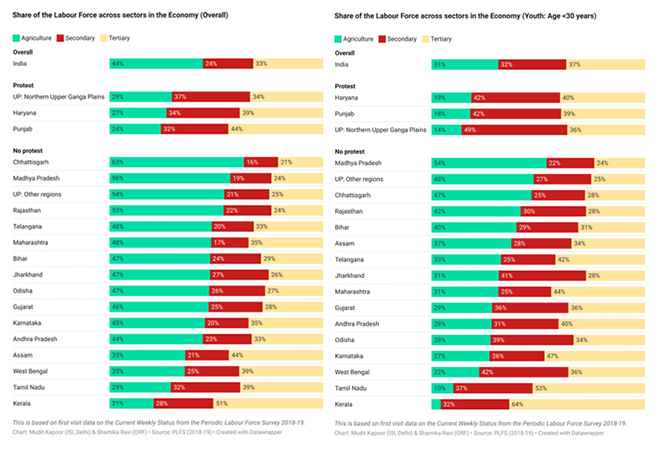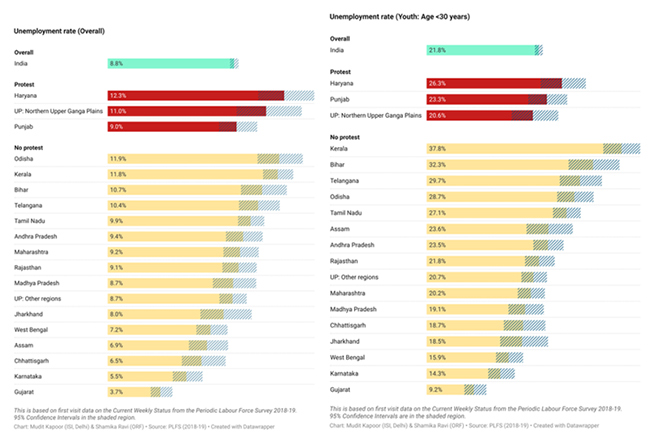Two issues dominated the political discourse in 2020-21; Pandemic and farmers protest against reform oriented agricultural laws. Farmers’ protests, which lasted more than a year, forced the popular government to repeal the agricultural laws in November 2021. The centers of farmers’ protest were districts in Punjab, Haryana and the North Upper Ganga Plain (NUGP). Uttar Pradesh. However, what remains an enigma is that these are the states or regions of the country with the least number of farmers! The share of labor force in agriculture in these three regions of the country is the lowest among the large states and is much lower than the national average.
The share of labor force in agriculture in these three regions of the country is the lowest among the large states and is much lower than the national average.
t. Using unit-level data on the current weekly status ofPeriodic Labor Force Survey for 2018-19The author found that the share of agriculture in Punjab was 24 per cent, in Haryana it was 27 per cent, and in the northern upper Gangetic plains of Uttar Pradesh, it was 29 per cent, while at the national level, the share of the labor force was the same. The agriculture sector had 44 percent. With reference to youth (age
One hypothesis has been proposed to explain the rise of peasant protests in these areas, that of local unemployment. The data shows that while Haryana and NUGP had higher levels of unemployment rate at 12.2 per cent and 11 per cent respectively, it was 9 per cent in Punjab, compared to the national level of 8.8 per cent, somewhat similar to the national level. However, more shocking is the fact that many of India’s larger states had significantly higher unemployment rates than Punjab, but there was no mobilization against the agriculture bills. Unemployment levels in other large states such as Odisha (11.9 percent), Kerala (11.8 percent), Bihar (10.7 percent), Telangana (10.4 percent), Tamil Nadu (9.9 percent), Andhra Pradesh (9.4 percent), Maharashtra (9.2 percent) percent), and Rajasthan (9.1 percent) indicate a higher level of employment crisis than Punjab.
Another possible explanation for the protest could be youth unemployment. However, when we compare Haryana, Punjab and NUGP with other large states, we find that these states had significantly lower youth unemployment rates as compared to larger states such as Kerala, Bihar, Telangana, Odisha and Tamil Nadu. From this, it appears that neither the overall unemployment situation nor the level of youth inaction of these regions may be the distinguishing features for the states of Punjab, Haryana and the NUGP that emerged as centers of farmers’ protests last year.
Therefore, it remains an enigma that Punjab, Haryana and the NUGP emerged as the sites of prolonged protests in the country – in principle – against the three Agriculture Acts introduced by the Parliament of India in September 2020. These protests found little or no resonance. In the rest of the country where the proportion of the farming population is quite high. Naturally, the question remains: what prompted these protests in India?
this piece was First published on ORF,
Shamika Ravi is a non-resident Senior Fellow of the Governance Studies Program at the Brookings Institution, Washington DC. The views expressed in this article are those of the author and do not represent the stand of this publication.
Read minute-by-minute news updates for Uttar Pradesh Election Result 2022, Punjab Election Result 2022, Uttarakhand Election Result 2022, Manipur Election Result 2022And Goa election result 2022,
Click here for seat-wise LIVE result Updates.

